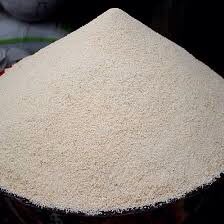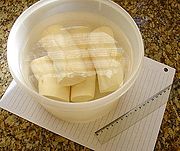Garri




InWest Africa,garri(also known asgari,galli,orgali)//is the flour of the fresh starchycassavaroot.
In theHausa language,garrican also refer to the flour ofguinea corn,maize, rice, yam, plantain and millet.[citation needed]For example,garin dawais processed fromguinea corn,garin masaraandgarin alkamaoriginate frommaizeand wheat respectively, whilegarin maganiis a powdery medicine.
Starchy flours mixed with cold or boiled water form a major part of the diet inNigeria,Benin,Togo,Ghana,Guinea,CameroonandLiberia.[citation needed]
Cassava, the root from whichgarriis produced, is rich in fiber, copper and magnesium.[1]
Garri is similar tofarofaof Brazil, used in many food preparations and recipes, particularly in the state ofBahia.
Preparation
[edit]
To makegarriflour,cassavatubers are uprooted, peeled, washed and grated or crushed to produce a mash. The mash can be mixed with palm oil and placed in a porous bag, which is then placed in an adjustable press machine or iron presser for 1–24 hours to remove excess water. Once dried, it issievedandfriedin a large stainless steel frying pot or in a large aluminum frying tray, with or without palm oil. The resulting dry granular garri can be stored for long periods. It may be pounded or ground to make a fine flour.[2]Garricomes in various consistencies, including rough, medium and smooth, which are used to prepare different foods.
Dishes
[edit]Ebais a stiff dough made by soakinggarriin hot water and kneading it with a wooden baton until it becomes a smooth doughy staple. It is served as part of a meal with soups and sauces. Some of these include okra soup,egusisoup,vegetable soup,afangsoup,bangasoupandbitter leaf soup.Similar starchy doughs are found as staples in other African cuisines.

Kokorois a Nigerian snack food common in southern and southeast Nigeria, especiallyAbia State,Rivers State,Anambra State,Enugu StateandImo State.It is made from a paste ofmaizeflour, mixed withgarriand sugar and deep-fried.
As asnack,cereal, or light meal,garrican be soaked in cold water (in which case it settles to the bottom), mixed withsugarorhoney,and sometimes roastedpeanutsand/orevaporated milk,also known as garri soakings. The amount of water needed for soakedgarriis 3:1.Garrican also be eaten dry with sugar and roasted peanut. Other ingredients include coconut chunks,tiger nutmilk, and cashews.
InLiberia,garriis used to make a dessert calledkanyanwhich is combined with peanuts and honey.

In its dry form,garriis used as an accompaniment for soft cookedbeansand palm oil. This food mix is calledyoo ke garri,orgarri-fɔtɔ/galli-fɔtɔ(crushed garri) in theGa languageofGhanaand theGendialect of southernTogoandBenin.This type of garri is a mixture of moistened garri kneaded with a thickened tomato paste, oil, salt, seasonings. Yoo ke garri is garri with beans, which is typically eaten as lunch.[2]It is also eaten with bean cake in Nigeria.
Smoothgarri(known aslebuto theYoruba) can be mixed with pepper and other spicy ingredients. A small amount of warm water andpalm oilis added and softened by hand. This type ofgarriis served with fried fish. It is served withfrejononGood Friday.
In Nigeria, the Efik people use drygarrito thicken light soup like 'egg soup and white soup (also known as up and down soup)
Variations
[edit]InWest Africa,two types of garri include white and yellow garri.Yellowgarriis prepared by adding palm oil just before the fermenting stage of the cassava mash.[3]Alternatively, it can be made using the yellow-fleshed breed of cassava. White garri on the other hand is fried without palm oil.
Variations of yellow and whitegarriare common across Nigeria and Cameroon. One variation of whitegarriis popularly known asgarri-Ijebu.This is produced mainly by theYoruba peopleofIjebuin Nigeria.
InGhana,garriis classified by taste and grain size. The sweeter types with finer grains are more valued over sourer, large grain varieties. Commercial food vendors prefer coarser grains with high starch content, as this produces a greater yield when soaked in water.
Buyers often look out for crisper grains when trying to determine freshness.
See also
[edit]References
[edit]- ^Nwosu, Martin (2023-08-23)."10 Amazing Health Benefits of Garri".Nccmed.Retrieved2023-08-23.
- ^ab"Garri".African Foods.RetrievedAugust 6,2015.
- ^"Garri: A Guide to West Africa's Staple Food".The Wisebaker. 16 September 2020.Retrieved2021-06-13.
